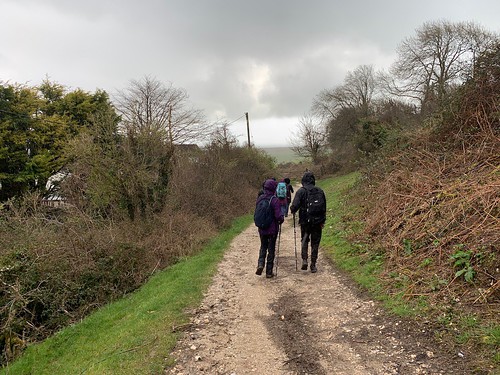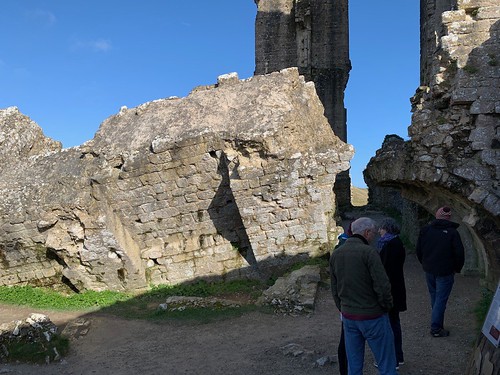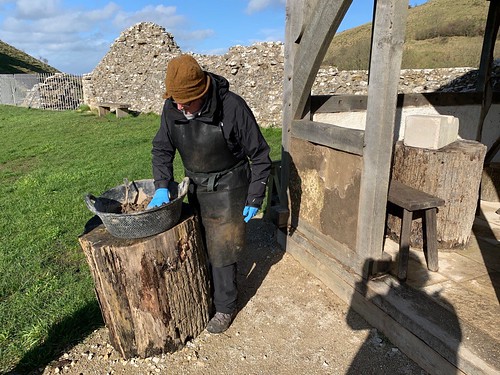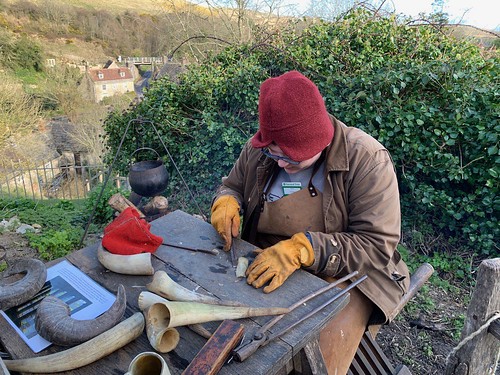Before we were so rudely interrupted by a global pandemic, your humble blogger was fed and showered and inhabiting an upper bunk at the Lulworth Cove Youth Hostel enjoying the righteous slumber of one who has hiked 20km in a wind tunnel and then downed half a bottle of very credible red wine. At least Sunday’s hike promised to be much shorter, though I was alarmed when the morning briefing included the warning that the day's route would be "quite exposed". ("What, compared to the cozy and sheltered outing yesterday?” I thought, and braced myself.) The weather forecast also wasn’t promising, with rain expected.
Nonetheless we dutifully packed our bags, tidied the hostel, and laced up muddy boots for a ramble to Old Harry Rocks, another of those wacky rock formations you find along the chalky south coast. First, though, we drove to the start of the hike in Swanage. One of the attractions of the group's itinerary that weekend was the chance of a ride on the steam train run by the Swanage Heritage Railway, though it was unclear during the previous evening’s planning whether the train was running that day.
But the train rides would have to wait, for there was hiking to be done. Astute Go Stay Work Play Live Readers will have noted the clear blue sky the the photo above but rest assured it did not last. Not long after striking out to the east along the beach in Swanage the skies clouded over and we all paused to put on our waterproofs just as the rain arrived. It wasn’t torrential by any means, but it was enough to dampen my spirits. It also didn’t help that not much later we passed though a small cluster of urbanity and saw a sandwich board out on the road advertising the local pub. It promised real ale and hot food and I knew that if I hadn’t been with the group I would have peeled off without the slightest hesitation to wait things out.
Luckily, the skies did clear and we made it to Old Harry Rocks in the sunshine. The rocks themselves are the remains of a chalk causeway that once linked the Isle of Wight to the mainland. The causeway eroded over time and left towering stacks of rock, one of which includes another natural archway (like Durdle Door) that will eventually turn into two stacks.
Naturally there were other people at the site taking in the view - you could just make out the Isle of Wight in the distance. But there were also signs warning people to stay away from the edge of the cliff, as there are along all those high chalk cliffs that edge the south coast. Equally naturally, there were also people blithely ignoring the signs, including one notable idiot who climbed down a particularly precarious path to a lower section of the headland. And just to make it that extra bit stupider, he did it with carrier bags tied over his shoes, so he had the least amount of grip possible. It was evolution in action, and we were all expecting to have to hang around and give statements to the air rescue pilots, so we quickly pressed on for the last leg of the walk back to Swanage.
By this time you can see that the skies had cleared a bit though it was still windy. However there were sheltered areas, and they were a welcome relief, until we encountered the last of the day’s obstacles.
The rain started up again once we reached Swanage and I was profoundly grateful that the promised group tea at the end of the walk had to be abandoned because the tea shop at the Steam Railway was closed. It was an easy excuse to quit the group, and Piran and I hurried back to the car to seek dry shoes and socks and to make our own plans for the rest of the day, which is when things got much, much better.
Corfe Castle is a magnificent ruin set on a hill above the town that bears its name, located smack in the middle of the oddly named Isle of Purbeck, which is patently a peninsula and not an island at all. One would think that a nation that produces maps so superlative that they differentiate between lighthouses, disused lighthouses and beacons and have different symbols for gravel pits as opposed to sand pits could have got this one right, but apparently not. Corfe Castle was built by William the Conqueror in the 11th century, and was one of the first castles in England to use stone as opposed to wood and earth. It was also one of the last Royalist strongholds during the English Civil War, before it fell to siege in 1645. After being captured, the castle was slighted on the orders of Parliament. And lest you think that slighting, in this context, means that it was not invited to the annual summer garden party, think again. This sort of slighting is a trifle more forceful than that and is a term used for deliberate damage to important buildings - especially castles - to reduce both their practical and symbolic value. In the case of Corfe Castle, they went so far as to use explosives, which is why many of the castles interior walls sit at a jaunty angle today.
That weekend the castle staff were demonstrating several different medieval crafts, including a station where one woman was busily engaged in mixing up a bucket of daub near a small outbuilding that had been constructed inside the castle walls using traditional techniques. A precursor to lathe-and-plaster construction, wattle-and-daub walls are made from a lattice of thin woven sticks (the wattle) set in a structural frame and covered in a sticky mix called daub. It’s often whitewashed over, resulting in the familiar half-timbered look we usually associate with Tudor building and endless suburbs.
And if you think hand-mixing animal dung into plaster is painstaking, consider the other traditional craft that was being demonstrated - the process of shaving animal horn into tiny translucent panes to be installed in a window frame, thus allowing a thin bit of yellowy light into an otherwise dark room.
Just visiting the castle and seeing the activities on display, especially on what turned into a lovely sunny day, would have been enough to lift my bedraggled spirits after the morning’s muddy tromp. But Corfe Castle ended up having much much more to offer because we’d arrived just in time to see the demonstration of the castle’s working trebuchet!
The Corfe Castle trebuchet uses 3/4 ton of counterweight, and is winched into position by volunteers from the crowd, which on that day included Piran and I. And perhaps because I might have hopped up and down chanting “pick me pick me”, we were the ones chosen to assist in the firing. Yay for unbridled enthusiasm! (Screw you disappointed children - only adults allowed for this activity!) Having spent last summer winding lock gates open and shut, Piran and I were both eminently qualified for winching activities.
Once the arm was in place the National Trust volunteer running the show carefully positioned the projectile - a plastic children’s ball filled with water weighing about 12kg - in the sling. And then, in an act of supreme generosity, Piran let me step forward when one of us was given the chance to actually FIRE the loaded trebuchet. (A thousand thank yous for that!) (Also, Piran is mounting a campaign to have his own tag on the blog. Perhaps that would be just reward for such a magnanimous gesture...). And that's how this happened:
The trebuchet was undoubtedly the highlight of my day (week, month, life…) but later I did also enjoy a very nice warm Cornish pasty and fortifying cup of hot tea from the award winning bakery in town. And we got to meet a lovely long-haired basset hound nearby, who had a charming name I neglected to write down. Let’s say he was called Chester. I also neglected to take a picture of Chester, but he was fantastic. (And: long-haired basset hound! Who knew?)
On the way back to London we took one last detour to experience the Sandbanks Ferry, a chain ferry that crosses the entrance to Poole Harbour between Sandbanks and Shell Bay. A chain ferry, of course, is a ferry that is guided back and forth by pulling itself along a chain that’s stretched between the two banks.
Once we got to Sandbanks we took a brief spin around what, unexpectedly, turns out to be the most expensive coastal property in the world. Hard to believe, but buying a house on Sandbanks’ Panorama Road will set you back more than if you have your sights set on Monte Carlo or Miami Beach. Apparently it’s popular with footballers, though John Lennon also owned a house there. Whatever the reason, we didn’t linger and soon hit the highway back to London and real life. Despite the wind and rain and mud and group-i-ness of it all, looking back from just six weeks later it seems positively idyllic. Bunking up with total strangers crammed into a crowded hostel. Visiting public attractions. Popping in and out of shops with reckless abandon. Ah, the good old days!
Nonetheless we dutifully packed our bags, tidied the hostel, and laced up muddy boots for a ramble to Old Harry Rocks, another of those wacky rock formations you find along the chalky south coast. First, though, we drove to the start of the hike in Swanage. One of the attractions of the group's itinerary that weekend was the chance of a ride on the steam train run by the Swanage Heritage Railway, though it was unclear during the previous evening’s planning whether the train was running that day.
Empirical evidence later proved that the train was indeed in operation.
And yet I didn’t. I’m still not sure why. This photo doesn’t really show the rain but it was there.
You can also just see the beginning of cave on the mainland in the bottom left of this photo. Eventually that will become and arch and then the opening under the arch will get taller and taller until that bit of the headland is cut off. And in case you think we’re talking about a geological time scale for this stuff, think again. Our guide Lee said that new cave wasn’t there when he did this hike a few months ago, which seems positively supersonic.
By this time you can see that the skies had cleared a bit though it was still windy. However there were sheltered areas, and they were a welcome relief, until we encountered the last of the day’s obstacles.
I’m not saying it was Passchendale out there, but for someone a bit fed up with the general environment and wearing shoes that had recently been discovered to have small holes in the waterproof lining, this was a LOT of mud. And this is just one of the long stretches of gumbo we traversed.
It’s time to retire these shoes.
Because we went to Corfe Castle!
Check out that jauntiness!
Small amounts of daub are usually mixed by hand, though larger batches were often mixed by animals stomping around on it. This woman’s recipe included clay, aggregate, horse manure and slaked lime. She was preparing it to repair the wall behind her.
This young woman, in her festive wooly cap, was using a sort of chisel to shave down the surface of a 1” x 2” bit of cow horn that had been boiled in the pot behind her. I know times were tough back then, but this seems slightly ridiculous. I know actual glass must have been rare and expensive, but who would possibly look at a bit of old cow horn and think, “You know, this stuff is ever so slightly translucent. I bet if I spent hours and hours of smelly, painstaking labour I could produce a minuscule piece of something slightly MORE translucent!"
This is a small scale version of the traditional siege engine. However, its size is modelled on an authentic “traveling trebuchet” that was actually built at the time. Trebuchets use a counterweighted arm to throw a projectile from a sling. Modern reproductions of the largest medieval ones stand up to 60’ high and can throw an 80 lb. projectile almost a thousand feet.
Once the arm was in place the National Trust volunteer running the show carefully positioned the projectile - a plastic children’s ball filled with water weighing about 12kg - in the sling. And then, in an act of supreme generosity, Piran let me step forward when one of us was given the chance to actually FIRE the loaded trebuchet. (A thousand thank yous for that!) (Also, Piran is mounting a campaign to have his own tag on the blog. Perhaps that would be just reward for such a magnanimous gesture...). And that's how this happened:
When I posted this video I titled it “Ready, Aim, Fire!”, but in my head it’s always been called: “Does this trebuchet make my ass look big?” (Answer: Yes. Yes it does.)
On the way back to London we took one last detour to experience the Sandbanks Ferry, a chain ferry that crosses the entrance to Poole Harbour between Sandbanks and Shell Bay. A chain ferry, of course, is a ferry that is guided back and forth by pulling itself along a chain that’s stretched between the two banks.
Chain and ferry, with Sandbanks in the background.














2 Comments:
Most of the ferries across the Saint John and Kennebecasis Rivers in New Brunswick are chain ferries. Fascinating as a kid whenever we had a ferry ride.
That video made my week!
Post a Comment